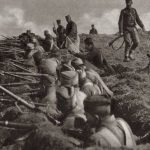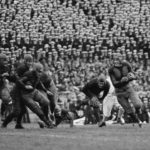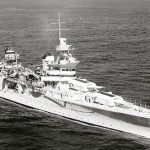 Technology
Technology  Technology
Technology  Humans
Humans 10 Everyday Human Behaviors That Are Actually Survival Instincts
 Animals
Animals 10 Animals That Humiliated and Harmed Historical Leaders
 History
History 10 Most Influential Protests in Modern History
 Creepy
Creepy 10 More Representations of Death from Myth, Legend, and Folktale
 Technology
Technology 10 Scientific Breakthroughs of 2025 That’ll Change Everything
 Our World
Our World 10 Ways Icelandic Culture Makes Other Countries Look Boring
 Misconceptions
Misconceptions 10 Common Misconceptions About the Victorian Era
 Mysteries
Mysteries 10 Strange Unexplained Mysteries of 2025
 Miscellaneous
Miscellaneous 10 of History’s Most Bell-Ringing Finishing Moves
 Technology
Technology Top 10 Everyday Tech Buzzwords That Hide a Darker Past
 Humans
Humans 10 Everyday Human Behaviors That Are Actually Survival Instincts
 Animals
Animals 10 Animals That Humiliated and Harmed Historical Leaders
Who's Behind Listverse?

Jamie Frater
Head Editor
Jamie founded Listverse due to an insatiable desire to share fascinating, obscure, and bizarre facts. He has been a guest speaker on numerous national radio and television stations and is a five time published author.
More About Us History
History 10 Most Influential Protests in Modern History
 Creepy
Creepy 10 More Representations of Death from Myth, Legend, and Folktale
 Technology
Technology 10 Scientific Breakthroughs of 2025 That’ll Change Everything
 Our World
Our World 10 Ways Icelandic Culture Makes Other Countries Look Boring
 Misconceptions
Misconceptions 10 Common Misconceptions About the Victorian Era
 Mysteries
Mysteries 10 Strange Unexplained Mysteries of 2025
 Miscellaneous
Miscellaneous 10 of History’s Most Bell-Ringing Finishing Moves
Ten Historical Last Stands Fought to the Death
A fighting force’s last stand tends to be romanticized from historical fact into pop culture and can consequently become quite embellished over time. Here are ten instances, some well-known, some obscure, in which the defenders fought to the death rather than yield another inch of ground to the enemy.
Related: 10 Bizarre Battles That Took Place Where You’d Least Expect
10 The Battle of Karbala (AD 680)
The Umayyad Caliph Mu’awiya died in April 680 and had named his son, Yazid, to become the next Caliph. This nomination was contested by Husayn, the son of Ali and the grandson of the Prophet Mohammed himself. When Yazid demanded Husayn’s allegiance, Husayn refused and traveled from Medina to Mecca, where he had greater support among the people.
With Yazid’s ascension to the throne, the first Muslim Civil War began, and the Battle of Karbala took place during it. Husayn traveled north on the first day of the Hajj, September 9, 680, across the Arabian Desert for Iraq. He had a retinue of about 70 men, and this may have swelled to about 150 by the time he arrived in southern Iraq.
His company reached Karbala on October 2, and an opposing force of 4,000, commanded by Umar ibn Sa’d, was dispatched by al-Hurribn Yazid al-Tamimi to intercept them. The two commanders met on the night of October 2 to try to resolve the matter peacefully, but no resolution was reached. On October 10, with ibn Sa’d’s army having approached Husayn’s camp during the night, the battle was joined.
Husayn only had men on horses, and they were rained upon by flights of arrows. Cavalry duels erupted, and hand-to-hand combat raged in the open desert while ibn Sa’d’s archers continuously fired. Husayn’s men were eventually forced to dismount once their horses became too wounded to move about. All of Husayn’s men were killed, and all the tents of his camp but his own were burned. His tent contained his family members, several of whom, including his son and half-brothers, chose to join the fighting. Every one of them was killed, including a child in Husayn’s own lap.
The Umayyad soldiers did not want to attack Husayn himself since they highly revered him as Mohammed’s grandson, until one of the Umayyads, Shemr, called out, “Shame! Why do you wait for the man? May your mothers forget you if you do not kill him!” They then attacked and wounded Husayn, and as he fell to the ground, he was stabbed and beheaded.[1]
9 Natalya Kovshova and Mariya Polivanova: German Summer Offensive (1942)
Kovshova and Polivanova joined a self-defense regiment in Moscow in 1941 in preparation for defending their capital city against the invading Germans. They were adherents of Soviet propaganda and consequently despised the Germans, especially after the latter began bombing civilians indiscriminately in many cities and towns. After serving as a control dispatch, Kovshova joined a sniper unit, and the two women quickly demonstrated their expertise in marksmanship and urban hunting. Polivanova served as Kovshova’s spotter and would also snipe soldiers when she could.
After the Battle of Moscow, the women were sent to the Northwestern Front, where they fought south of St. Petersburg (Leningrad). Kovshova trained many other snipers, and their unit severely hampered the German offensive in the Novgorod area. By August 1942, they were fighting outside the village of Sutoki-Byakovo, and German machine gunners and artillery were slowly but surely wiping out the Soviet snipers.
Eventually, Kovshova and Polivanova were the only two left, and rather than surrender, they decided to fight until they exhausted their ammunition. They then pulled the pins on all the grenades at their disposal and waited for the Germans to rush into close-quarters combat, at which point they tossed their grenades and died in the explosions. It is not known with certainty if their grenades killed any Germans.[2]
8 The Battle of the Persian Gates (330 BC)
By 330 BC, the Persian Empire was in full retreat from the advancing Macedonians under Alexander the Great, who had just enjoyed the most significant victory of his entire career at Gaugamela. He had reached the ancient cities of Babylon and Susa and proclaimed himself King of Persia in Darius III’s absence. He divided his army in two, leaving half with his most trusted general, Parmenion, and the other half for himself.
From there, Alexander traveled through the province of Persis, today called Fars, in Iran, and wandered into an ambush prepared by Ariobarzanes commanding probably about 2,000 men. Alexander had 10,000, but Ariobarzanes hoped to nullify that number via the narrow mountainous pass of the Persian Gates. The Battle of Thermopylae had already become legendary by then. Ariobarzanes’s intention was to protect the capital city of Persis, Persepolis, as long as he could.
Once Alexander’s men reached the chokepoint, only several meters wide, the Persians began rolling huge boulders down on them, along with volleys of arrows. Alexander began losing hundreds of men in mere moments and was forced to leave the dead unburied on the battlefield, something he abhorred. The Persians held the pass for one month until prisoners of war, probably under threat of torture, informed Alexander’s army of another route around the pass.
Ariobarzanes and his men were now surrounded and fought to the death, wrestling the Macedonians to the ground and killing them with their own weapons until no Persians were left alive. Alexander pressed on to and sacked Persepolis.[3]
7 The Battle of Stamford Bridge (1066)
This engagement took place less than three weeks before the much more famous Battle of Hastings. King Harold Godwinson, killed in battle at Hastings, led between 10,000 and 15,000 foot soldiers and 2,000 cavalry 185 miles (298 km) in just four days to catch the Vikings by surprise. The latter numbered 9,000 to 11,000 men, led by Harald Hardrada, King of Norway. The battle is believed to have been fought just west of a wood bridge, no longer extant, over the Derwent River in present-day Yorkshire.
The battle itself was not the last stand. That came at the moment the battle began, in the form of a single unknown Viking who, armed with a single ax, defended the bridge by himself against the entire English army. He was able to kill as many as 40 English soldiers before another swam under the bridge and shoved a spear between the planks into the Viking’s groin, killing him.
That Viking’s last stand gave the rest of the Viking army time to form a shield wall on the other side of the bridge, but the Vikings chose not to wear their armor, and this proved their downfall. The English pressed hard against them for hours until the Norse army collapsed and was slaughtered nearly to the last man.[4]
6 Operation Anthropoid (1942)
The title is the codename for the assassination of Reinhard Heydrich on May 27, 1942, by the Czech Resistance. The assassins—Jan Kubis and Jozef Gabchik—were trained by British Intelligence for the mission and intended to either shoot Heydrich during a planned motorcade or blow him up in his car using an anti-tank mine.
Gabchik stood in wait with a Sten submachine gun under his trench coat at an intersection and attempted to fire, but the gun jammed. Heydrich, true to form, ordered the car to stop, not to escape, but so he could shoot back as he stood up in the backseat. Kubis then threw a briefcase with the mine inside, and it detonated just behind the right rear wheel. Heydrich was mortally wounded by shrapnel and upholstery, the latter of which caused a fatal infection.
The assassins fled into hiding for the next month, then joined the rest of their squad in the basement of the Cathedral of Sts. Cyril and Methodius. They were sold out by turncoat Karel Curda, who accepted the Nazis’ offer of one million Reichsmarks and acted as a Gestapo informant for the rest of the war. The Czechs hanged him in 1947.
On June 19, 750 SS troops laid siege to the church and tried to drive the assassins out with tear gas. When this didn’t work, they began flooding the basement with fire hoses. The Nazis were eventually able to get inside, where they found the defenders dead. Kubis and two others had died from gunshot wounds during the two-hour standoff. The rest, including Gabchik, had shot themselves in the crypt rather than be taken and tortured to death.[5]
5 The Last Stand at Wu River: Battle of Gaixia (202 BC)
This battle took place between the Kingdoms of Han and Western Chu in what is now Guzhen County Anhui, in northeastern China. The country had been unified under the Qin Dynasty since 210 BC. When the emperor died that year, uprisings began to break out. They escalated into a civil war primarily fought between the Han and the Chu.
By the time of the Battle of Gaixia, the Han Dynasty had gained the upper hand with a much larger army, and Chu was permanently on the defensive. The Chu faction was able to field its final 100,000 men in combat. The Han fielded about 300,000, and their commander, Han Xin, used battlefield tactics similar to those of Hannibal Barca in the Battle of Cannae.
The Han center at first advanced against the veteran Chu soldiers directly opposite them but then feigned an orderly retreat, and the Chu center followed them. This allowed the Han flanks to slowly envelop the Chu army, now in a salient formation, and surround it. The Chu army was cut down to the tune of 80,000 killed. The remaining 20,000 surrendered. Han’s losses are not known but are probably much lighter. The Chu commander, Xiang Yu, fled the field with a few thousand men until they reached the Wu River.
There, his men began deserting for their nearby homelands, and with the Han cavalry in rapid pursuit, Xiang Yu chose not to continue fleeing for his own home but to turn and fight to the death with his back to the river. He was personally able to kill hundreds of Han soldiers and sustained a dozen wounds before he finally chose to cut his own throat. His body was ripped to pieces.[6]
4 The Siege of Szigetvár (1566)
The Ottoman (Muslim) invasion of what is now Hungary and Croatia lasted for most of the adult life of Suleiman I, called the Magnificent, who intended to expand the Ottoman Empire and conquer as much of Catholic Europe as he could. He laid siege to Vienna over thirty years before the events of this entry but could not overcome its defenses. Szigetvár, meanwhile, was a fortress town in the Mecsek Mountains, well placed near the Danube River for supply and both offense and defense.
The siege lasted from August 6 to September 8, during which 50,000 to 100,000 Ottoman soldiers laid siege with 300 cannons against the Hungarian and Croatian garrison of 2,300 to 3,000 men, led by Nikola IV Zrinski. Zrinski’s men put up such a stubborn, impregnable defense that Suleiman offered Zrinsky the whole of Croatia if he would surrender. Zrinsky refused. His garrison held the attackers off with heavy casualties on both sides, retreating over the course of 33 days into tighter and tighter perimeters within the fortressed town.
Suleiman ultimately died of old age at 72 the night before the final day of combat during this siege while in his tent on the night of September 6. The next morning, his men breached the walls of the innermost fort and advanced through the streets with drums and shouting. It was at this point that Zrinsky and the last surviving 600 or so men of the Szigetvar garrison chose to charge the Ottoman lines on horseback rather than surrender and live as prisoners.
Zrinksy was shot down on the bridge between the outer and inner forts, and the garrison died to the last man. He had given orders before charging out that the powder magazine in the inner fort should be lit with a long fuse. The invading Ottomans had no idea what they were running into, and 3,000 of them were blown up in the explosion. With Suleiman dead, the Ottoman commanders ultimately decided to withdraw since winter was coming.[7]
3 The Battle of Britain (1940)
This battle took place entirely in the air and can be thought of as a last stand since the Germans could not be guaranteed a successful land invasion of the British Isles until they had first established absolute air superiority by obliterating Britain’s air force. They almost succeeded and probably would have had Hitler not insisted on micromanaging the war and ordering the Luftwaffe to stop bombing military air bases and focus on bombing civilian urban areas in what is now known as the London Blitz.
Hitler’s intention was to break the resolve of the British people, but of course, this sort of indiscriminate mass murder only strengthened the people’s will to fight to the last man, woman, and child. Churchill said it best when he stated to Parliament the people’s intention to fight for every square inch of ground until no one was left alive on it.
Fortunately, Britain’s air defenses, led by Air Chief Marshal Hugh Dowding, were able to defeat Hitler’s Operation Sea Lion in the air. Dowding understood the situation even better than Churchill and repeatedly refused to send their precious warplanes to air in the Battle of France. It was Dowding’s proper management of Britain’s air resources that saved the British Isles from a German seaborne land invasion.
History often ponders how horrible such a land invasion would have been for both sides, in the same vein as Operation Downfall, the planned American invasion of the home islands of Japan. Ultimately, while the Luftwaffe was bombing London, the British air force was bombing the Luftwaffe’s forward air bases in France and Belgium. London could take it. The Luftwaffe could not and finally retreated.[8]
2 The Battle of Wegrow (1863)
This was quite a small battle compared to the other entries on this list, but a last stand is a last stand, and this one was immortalized by poet Henri Barbier, among others, and is remembered today as the Polish Thermopylae. The Polish, as a people of the Kingdom of Poland, were subject to the rule of Russia and launched an uprising in January, which lasted a year and a half. They wanted to be their own nation under their own rule. The Russians sought to quell the uprising in the area of its origin, the small town of Wegrow.
The Russians intend to recapture the town with a force of 1,000 men, both infantry and cavalry, and six cannons under the command of Colonel Georgi Papaafanasopulo. They were opposed by about 3,500 Polish infantrymen led by Jan Matlinkski. Matlinkski saw that his force could not withstand repeated attacks by the Russian cavalry and cannons and ordered a fighting retreat from the town. He ordered about 500 men armed with war scythes to remain as a rearguard to delay the Russians for as long as possible.
These 500 Poles, with their long, curved poleaxes, knew they would not survive but still charged the Russian left flank, attacking primarily the cavalry in an effort to scare the horses. They succeeded in turning back the Russian cavalry and tried to capture the cannons but were killed almost to the last man by Russian infantry fire.[9]
1 The Siege of Masada (c. AD 72–74)
The Roman Tenth Legion under Lucius Flavius Silva besieged the Jews at the hilltop of Masada for several months beginning in the winter of either AD 72 or 73. The Jews were rebels belonging to what Rome dubbed the “Sicarii,” or “of the daggers.” These Jews despised Roman rule and influence in Judea and became an organized crime syndicate, surreptitiously stabbing both Romans and other Jews to death at large gatherings and then disappearing into the crowds. They murdered 700 Jews at the village of Ein Gedi at Passover in 67 AD. Rome eventually deemed it necessary to eliminate them.
The siege began with the Romans building walled camps for themselves, a circumvallation around the entire mountain, and then constructing an earthen ramp up to the top. The defenders, led by Eleazar ben Ya’ir, could do nothing but watch. By the spring of the next year, the ramp was fully built, and a giant siege tower was constructed and slowly rolled uphill.
The Romans launched ballistae and catapults of torches at the wood ramparts to drive the defenders away and ultimately breached the wall. Once they entered the fortress, they found that the Jews had burned every building to the ground and stabbed each other to death in a mass suicide. The Jews probably expected that if taken alive, they would be crucified. Masada still exists today, is a national park, and can be toured year-round. The fortress’s buildings still stand as ruins, as do the Roman siege works and camps.[10]








